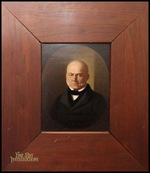John Quincy Adams, 1844, George Caleb Bingham’s historically most important portrait, is going up for auction on December 6, 2015, at Grogan & Company. Adams recorded his sittings with two artists who shared a studio in the Capitol in Washington, D.C.: George Caleb Bingham and John Cranch (1807-1891), Adams’ great-nephew, in his diary for May 23 and May 27, 1844. May 23 was rather uneventful, For May 27,1844, Congressman John Quincy Adams, human rights activist, former ambassador and President, wrote these words:
This was the day on which the two Democratic Conventions to nominate candidates for the offices of President and Vice-President of the United States for four years from the 4th of March next, were held at Baltimore, and also a Convention to nominate a candidate for the office of Governor of Maryland. By the new invention of the electro-magnetic telegraph of Professor Morse, the proceeding of those bodies throughout the day were made known here at the Capitol, and announced as soon as received, in manuscript bulletins suspended to the wall in the rotunda. I gave an hour’s sitting to Mr. Cranch and Mr. Bingham, after calling at the National Intelligencer office and leaving with Mr. Gales a continued list of petitions presented by me since the 5th of April, and with it I left the Boston Courier of the 14th, containing the memorial relating to the statistics of the census, which I requested Mr. Gales to republish, with a reference asterisk from the entry of the memorial on my list. The use made by John C. Calhoun, in his correspondence with Mr. Pankham, of the enormous blunder in the census, and his prevarication in denying in an official report that any errors had been discovered in the census, betray so total a disregard of all moral principle that it can be attributed only to the alternative of absence of honesty or of mental sanity. ‘Tis the fanaticism of the slave-monger.
At the House, the business of the day dragged heavily along. About seventy members, chiefly of the Democratic majority, were absent at Baltimore; yet enough remained to control the action of the House and dictate what should be done. Mr. Grinnell offered a resolution requesting the joint Committee on the Library to consider the expediency of publishing three thousand copies of certain surveys of the exploring expedition, and selling them to defray the cost of publication; which was adopted.
Committee of the whole on the state of the Union, Reuben Chapman, of Alabama, in the chair; and George S. Houston, of the same Alabama, drove through two land bills, which were reported to the House. Weller moved to adjourn over to Wednesday, but, on call of the yeas and nays, withdrew the motion. I had insisted upon a call of the yeas and nays, to ascertain the quorum in the House – one hundred and ten and nineteen. Adjourned at three. I went into the Senate-chamber, and hear William C. Rives close a three hours’ tariff speech.
Charles Francis Adams, ed., Memoirs of John Quincy Adams Comprising His Diary from 1795 to 1848 (J. B. Lippincott & Co., 1877), 35-36
George Caleb Bingham painted three portraits of Adams, but the one going up for sale is the original, the one he copied to create the portraits now owned by the Smithsonian’s National Portrait Gallery and the Detroit Institute of the Arts, If you have time to look, you may agree that the original is the best of them all.


